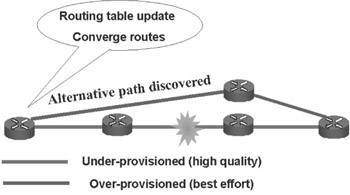Reviewing Routing
|
| < Day Day Up > |
|
Remember that in a routed network (see Figure 4.5), data is connectionless, with no real QoS. Packets are routed from network to network via routers and routing tables.

Figure 4.5: Standard Routing
Alternative Paths
If a link or router fails, an alternative path is eventually found and traffic is delivered. If packets are dropped in the process, a Layer 4 protocol (such as TCP) will retransmit the missing data.
This method works well for transmitting non-real-time data, but when it comes to sending real-time packets (such as voice and video), delays and dropped packets are not tolerable.
IGP Rapid Convergence
To address routing-convergence problems, OSPF and IGP working groups have developed IGP Rapid Convergence, which reduces the convergence time of a routed network to approximately 1 second.
The benefits of using IGP Rapid Convergence include both increased overhead functions and traffic on the network; however, it only addresses half the problem posed by MPLS. The challenge of maintaining QoS parameter tunnels is not addressed by this solution.
|
| < Day Day Up > |
|
EAN: 2147483647
Pages: 138